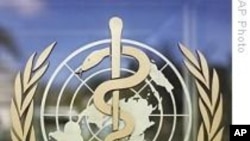The World Health Organization says more than four million HIV-positive
people are receiving life-saving anti-retroviral treatment. A new
report launched by WHO, UNAIDS and UNICEF finds the greatest progress
is being made in sub-Saharan Africa, where two-thirds of all HIV
infections occur.
The report says access to anti-retroviral
therapy continues to expand at a rapid rate. Data show at the end of
2008, 36 percent more HIV-positive people were receiving treatment than
in the previous year.
Director Ad Interim, HIV/AIDS Department
at the World Health Organization, Teguest Guerma, notes this represents
a tenfold increase over five years. Despite this progress, she says
global coverage remains low.
She says only five-and-one-half-million of the nine-and-one-half-million people infected are getting the treatment they need.
"But,
those who are getting treatment are also starting too late because of
late diagnosis," she said. "People are coming to the health services
when they are sick. And, this is having an impact on survival rate.
People are dying during the first 12 months of treatment."
The
report finds prices of the most commonly used anti-retroviral drugs
have dropped significantly in recent years. And, this has boosted the
number of people able to get treatment. Among the main beneficiaries
are women and children.
Surveys show about 45 percent of
HIV-positive pregnant women received anti-retroviral drugs to prevent
HIV transmission to their children last year. This is up from 35
percent in 2007. In addition the number of children under age 15
receiving treatment also is rising.
UNAIDS Executive Director
Michel Sidibe says progress in Africa is particularly dramatic. He
notes the number of HIV-positive people receiving anti-retroviral
treatment in sub-Saharan Africa has risen from 50,000 a few years ago
to nearly three-million today.
But, treatment without prevention, he believes, is like walking in place.
"We
do not see any level off in this old fight against HIV," he said. "We
still have 2.7 million new infections ... So, that means almost, if
we compare to the one million we added last year to the treatment, it
is almost one out of three. Anytime we are putting one person on
treatment, new person on treatment, we have three new infections."
He says the number of people on treatment will never decline unless new infections are prevented from occurring.
The
health agencies estimate they need $25 billion for 2010 to pay for a
comprehensive package of HIV/AIDS-related activities. These include
raising the number of people on treatment to seven million, promoting
prevention programs and strengthening health care systems in developing
countries.
News
More Than 4 Million HIV-Positive People Receiving Life-Saving Treatment
update
- By Lisa Schlein

<!-- IMAGE -->




